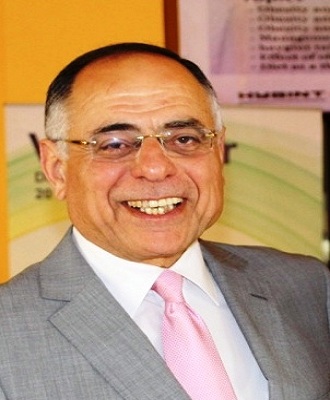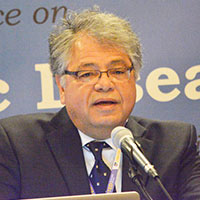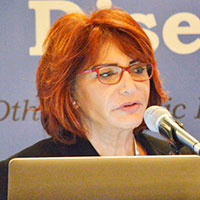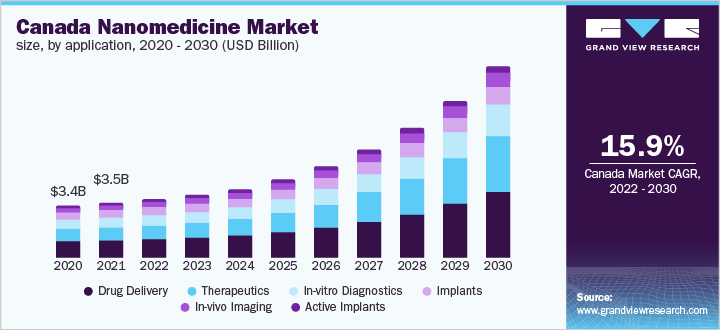Renowned Speakers

satoshi fujji
Monash university Australia

Aboubakr Elnashar
Benha University Egypt

Peng sheng wei
Begische university

Dr. Alexander de St. Amatus
Australian Institute of High Energetic Materials Australia

Reza hakak
University of Arkansas for Medical Sciences, USA USA

Masahiro hiramoto
osaka university , japan Japan

Nahla Hwalla
American university of beirut
Recommended Global Nanotechnology Webinars & Conferences
Asia Pacific & Middle East
Canada
Nanomedicine-2023
- About Conference
- Why to Attend
- Target Audiences
- Sessions/Tracks
- Market Analysis
- Past conference Report
About Conference
Nanomedicine 2023 is very excited to welcome participants all over the world to attend "32nd International conference on Nanomedicine & Drug Delivery" scheduled during November 27-28, 2023 at Barcelona, Spain
Nanomedicine 2023 will illustrate innovative Research ideas on Nano medicine, Drug Delivery, Pharmaceutical Technology, Medical Devices for Drug Delivery, Biotechnology, Nano robotics, and Formulation Technology.
Nanomedicine is the medical application of nanotechnology. Nanomedicine ranges from the medical applications of nanomaterials and biological devices to nanoelectronic biosensors and even possible future applications of molecular nanotechnology such as biological machines.
Drug delivery refers to approaches, formulations, manufacturing techniques, storage systems, and technologies involved in transporting a pharmaceutical compound to its target site to achieve a desired therapeutic effect. Many current applications of nanomedicine are providing improvements to drug delivery for therapy.
This conference presents a fantastic line-up for many international experts such as Professors and Ph.D Scholars from academia,R&D Scientists, CEOs, CROs, CMOs, Director, President from Pharmaceutical Companies, Manufacturers, Distributors and Suppliers of Drug Delivery Technologies, Business Entrepreneurs, Health professionals & Pharmacist, Quality control specialist. It provides interdisciplinary platform to present and discuss the most recent innovations, trends as well as practical challenges encountered and solutions adopted in the fields Nanomedicine & Drug Delivery
Why to Attend
Top Reasons to Attend
- It’s the unique opportunity to discuss issues of importance and relevance to advancing Nanomedicine and Drug delivery system through professional development.
- The conference is of interest to all those in the Continuing Education/Professional Development experience, including pharmacists, developers, sponsors, faculty, regulators, government, professional associations, pharmaceutical industry, communication companies, and allied health care providers and organizations from around the world.
- Meet with key decision makers in the pharmaceutical industry worldwide and learn about the latest innovations, technologies, trends and developments in pharmaceutical industry.
- Network and gain access to one of the world's fastest growing pharmaceutical markets.
- A momentum is growing world-wide that recognizes the integral role of continuing professional development in Pharmaceutical Industry, and the value of sharing experiences and knowledge in an international, collegial forum.
- The conference facilitates participant access to high quality educational programs, internationally significant research and development, and world-renowned leaders in the Pharmaceutical field.
- This is the only event featuring renowned speakers and delegates and expertise on the topics you care about most
Target Audiences
Target Audience
- Professors, Associate Professors, Asst Professors
- PhD Scholars
- Graduates and Post Graduates
- Directors, CEO’s of Organizations
- Association, Association presidents and professionals
- Noble laureates in Health Care and Medicine
- Bio instruments Professionals
- Research Institutes and members
- Supply Chain companies
- Manufacturing Companies
- Training Institutes
- Business Entrepreneurs
Sessions/Tracks
Track 1: Nanomedicine
Nanomedicine is a branch of medicine that applies the knowledge and tools of nanotechnology in the prevention and treatment of diseases. Nanomedicine involves the use of nanoscale materials, such as biocompatible nanoparticles and Nano robots, for diagnosis, delivery, sensing or actuation purposes in a living organism. The physicochemical and biological properties of the Nanoparticles can also be finely adjusted by tailoring their chemical properties, sizes, shapes, structures, morphologies, and surface properties. Nanomedicine is the medical application of Nanotechnology. Nanotechnology has provided the possibility of delivering drugs to specific cells using nanoparticles. Current problems for nanomedicine involve understanding the issues related to toxicity and environmental impact of nanoscale materials.
Nanomedicine seeks to deliver a valuable set of research tools and clinically useful devices in the near future. The National Nanotechnology Initiative expects new commercial applications in the pharmaceutical industry that may include advanced drug delivery systems, new therapies, and in vivo imaging.
Track 2: Drug Delivery system
Drug delivery describes the method and approach to delivering drugs or pharmaceuticals and other xenobiotics to their site of action within an organism, with the goal of achieving a therapeutic outcome. The field of drug delivery has advanced dramatically in the past few decades, and even greater innovations are anticipated in the coming years. Biomedical engineers have contributed substantially to our understanding of the physiological barriers to efficient drug delivery and have also contributed to the development of several new modes of drug delivery that have entered clinical practice.
Track 3: Pharmaceutical nanotechnology
Pharmaceutical nanotechnology is the exciting, rapidly emerging branch of medical science that deals with harnessing nanoscale materials as drug delivery and/or diagnostic tools. As drug delivery tools, nano-delivery systems can be used to enhance the site-specific, targeted delivery of precise medicines.
Pharmaceutical Nanotechnology based system deals with emerging new technologies for developing customized solutions for drug delivery systems. The drug delivery system positively impacts the rate of absorption, distribution, metabolism, and excretion of the drug or other related chemical substances in the body. Pharmaceutical nanotechnology embraces applications of nanoscience to pharmacy as nanomaterials, and as devices like drug delivery, diagnostic, imaging and biosensor.
Track 4: Nanorobotics and Nanomedicine
Nanomedicine will be based on the ability to build Nanorobots. In the future these Nanorobots could actually be programmed to repair specific diseased cells, functioning in a similar way to antibodies in our natural healing processes. The motivation for the new manipulation technology is the desire to enter the micro and Nanoworld not only by viewing but also acting, altering micro- and nanosized objects. A new era on medicine are expected to happen in the coming years. Due to the advances in the field of Nanotechnology, Nanodevice manufacturing has been growing gradually. The elimination of bacterial infections in a patient within minutes, instead of using treatment with antibiotics over a period of weeks.
Track 5:Smart Drug Delivery Technology
The development of the smart drug delivery system (SDDS) is a revolution of nanotechnology in the pharmaceutical and medical fields. Nanomaterials through their enhanced target specificity, biodistribution, and plasma retention have overcome the therapeutic adverse effects of the conventional drug delivery system. The response-based intelligence of the system helps to release drug payloads released under specific pathological conditions. The development of an intelligent drug delivery system combines multiple approaches and multiple signal responses to improve their applicability in diagnosis as well as therapy.
Track 6: Nanorobotics
Nanomedicine will be based on the ability to build Nanorobots. In the future these Nanorobots could actually be programmed to repair specific diseased cells, functioning in a similar way to antibodies in our natural healing processes. The motivation for the new manipulation technology is the desire to enter the micro- and Nanoworld not only by viewing but also acting, altering micro- and nanosized objects. A new era on medicine are expected to happen in the coming years. Due to the advances in the field of Nanotechnology, Nanodevice manufacturing has been growing gradually. The elimination of bacterial infections in a patient within minutes, instead of using treatment with antibiotics over a period of weeks.
Track 7: Computational studies in Nanoparticles
The computational studies in nanoparticles have demonstrated that there has been considerable progress in Nano and biotechnology in the last several years. However, several key challenges have also become apparent, including the need for a better understanding of nanoparticle behaviour in vivo and the development of more effective nanoparticle therapeutics. Computational efforts are becoming an important tool in addressing both of these challenges, as well as in generally facilitating and accelerating nanotechnology-based translational research. The Nanoinformatics has come out as a new research area that covers raw data management, analysis of the data derived from biomedical applications and simulation of nanoparticle interactions with biological systems depicting the integration of biology, nanotechnology and informatics to form the basis for computational Nanomedicine.
Track 8: Research and Development of Nanomedicine
Nanomedicine has been developing rapidly in recent years, particularly in the development of novel Nano tools for medical diagnosis and treatment. For instance, a new trend is becoming prevalent in developing Nanosystems for simultaneous tumour diagnosis and therapy. A new terminology "Theranostics" has been frequently used and applied in pre-clinical research and trials. A Nanosystem can simultaneously achieve both cell targeted in vivo imaging and photothermal treatment of cancer. While achieving concurrent high spatial and temporal resolution of the lesions via cell targeting; special non-evasive treatments are implemented at the same time by various means, such as localized drug release, hyperthermia, and photo-thermal therapy. Inspired by these challenging problems in biomedical fields, the development of the nanotechnologies will be the key in addressing some of the critical issues in medicine, especially in early cancer diagnosis and treatment.
Track 9: Nanoparticles as precise Drug Delivery systems
With the remarkable development of Nanotechnology in recent years, new drug delivery approaches based on the state-of-the-art nanotechnology have been receiving significant attention. Nanoparticles, an evolvement of nanotechnology, are increasingly considered as a potential candidate to carry therapeutic agents safely into a targeted compartment in an organ, particular tissue or cell. These particles are colloidal structures with a diameter less than 1,000 nm, and therefore can penetrate through diminutive capillaries into the cell’s internal machinery. This innovative delivery technique might be a promising technology to meet the current challenges in drug delivery. The different types of nanoparticles drug delivery systems under investigation and their prospective therapeutic applications, and also present a closer look at the advances, current challenges, and future direction of nanoparticles drug delivery systems.
Track 10: Polymer Nanoparticles for Nanomedicine
The use of nanoscale materials and processes to address human disease is perhaps the most promising, considering that most complex downstream symptoms of disease are initiated by molecular level phenomena. Nanomedicine is defined as biological and medical intervention at the nanometer scale for the treatment, diagnosis, and increased understanding of biology and disease. Tremendous advances in the area of polymer synthesis and self-assembly have given rise to a new toolbox of engineered nanosized delivery and diagnostic agents that permit systemic and local administration, circulation in the bloodstream, and uptake and diffusion at the cellular and subcellular level.
Track 11: Design and Characterization of Nano Drug System
Recent years have witnessed the rapid development of inorganic nanomaterials for medical applications. At present, nanomedicines-nanoparticles (NPs) destined for therapy or diagnosis purposes-can be found in a number of medical applications, including therapeutics and diagnosis agents .Pushing the limits of nanotechnology towards enhanced Nanomedicines will surely help to reduce side effects of traditional treatments and to achieve earlier diagnosis. The interplay between engineered nanomaterials and biological components is influenced by complex interactions which make predicting their biological fate and performance a nontrivial issue. We hope that both early-stage and experienced researchers will find it valuable for designing nanoparticles for enhanced bio-performance. Nanoemulsions have attracted great attention in research, dosage form design and pharmacotherapy. This is as a result of a number of attributes peculiar to nanoemulsions.
Track 12: Toxicology of Nanoparticles
Nanotechnology is a rapidly growing field having potential applications in many areas. Nanoparticles have been studied for cell toxicity, immunotoxicity, and genotoxicity. Tetrazolium-based assays such as MTT, MTS, and WST-1 are used to determine cell viability. Different types of cell cultures, including cancer cell lines have been employed as in vitro toxicity models. Considering the potential applications of NPs in many fields and the growing apprehensions of FDA about the toxic potential of Nanoproducts, it is the need of the hour to look for new internationally agreed, free of bias toxicological models by focusing more on in vivo studies. The rapid expansion of nanotechnology promises to have great benefits for society, yet there is increasing concern that human and environmental exposure to engineered nanomaterials may result in significant adverse effects. The system was developed for Nanotoxicity assessment at single and multiple cell levels which can measure and compare the microscopic and macroscopic effects of nanoparticles interaction with cells, without interference from neighbouring cells' cues and also overall integrative effects produced by nanoparticles and cell–cell communication.
Track 13: Emerging Nanomedicine
Currently, the treatment of HIV requires regular oral dosage of HIV drugs, and chronic oral dosing has significant complications that arise from the high pill burden experienced by many patients across populations with varying conditions leading to non-adherence to therapies. Recent evaluation of HIV patient groups have shown a willingness to switch to nanomedicine alternatives if benefits can be shown. Research efforts by the Liverpool team have focused on the development of new oral therapies, using Solid Drug Nanoparticle (SDN) technology which can improve drug absorption into the body, reducing both the dose and the cost per dose and enabling existing healthcare budgets to treat more patients
Track 14: Pharmaceutical Formulations
Formulation studies involve developing a preparation of the drug which is both stable and acceptable to the patient. For orally administered drugs, this usually involves incorporating the drug into a tablet or a capsule. It is important to make the distinction that a tablet contains a variety of other potentially inert substances apart from the drug itself, and studies have to be carried out to ensure that the encapsulated drug is compatible with these other substances in a way that does not cause harm, whether direct or indirect. Formulation studies also consider such factors as particle size, polymorphism, pH, and solubility, as all of these can influence bioavailability and hence the activity of a drug.
Track 15: Applied Pharmaceutical sciences
Pharmacy is the science and technique of preparing and dispensing drugs. It is a health profession that links health sciences with chemical sciences and aims to ensure the safe and effective use of pharmaceutical drugs. A theory relating chemical structure to pharmaceutical activity emerged from the interplay of experimental results from animal and human tests using vaccines, antitoxins, and antibodies with chemical knowledge about dyes and their molecular structures. Although pharmacology is essential to the study of pharmacy, it is not specific to pharmacy. Pharmacoinformatics is considered as another new discipline, for systematic drug discovery and development with efficiency and safety. The progressively more important role of the chemist and chemical science in pharmaceuticals in the early-20th century is mirrored in the history of the American Chemical Society's Division of Medicinal Chemistry
Track 16: Nanotechnology in Biology
Nanotechnology is enabling technology that deals with Nano- cadence sized objects. It's anticipated that nanotechnology will be developed at several situations accoutrements , bias and systems. The combination of biology and nanotechnology has led to a new generation of Nano bias that opens the possibility to characterize the chemical, physical, mechanical, and other molecular parcels. And it can be indeed used to characterize the single motes or cells at extraordinarily high outturn. Nanoparticles with distinctive chemical compositions, sizes, shapes, and face chemistries can be finagled fluently and this fashion has wide range of operations in natural systems. mileage of nanotechnology to biomedical lores indicate creation of accoutrements and bias designed to commerce insub-cellular scales with a high degree of particularity.
Track 17: Nanobubble in Nanomedicine
In recent times, microbubble and Nano bubble technologies have drawn great attention due to their wide operations in numerous fields of wisdom and technology, similar as water treatment, biomedical engineering, and nanomaterials. Nano bubbles parade unique characteristics; due to their nanosecond size and high internal pressure, they can remain stable in water for dragged ages of time. Nanobubbles can be created when gold nanoparticles are struck by short ray beats. The short- lived bubbles are veritably bright and can be made lower or larger by varying the power of the ray. Because they're visible under a microscope, nanobubbles can be used to either diagnose sick cells or to track the explosions that are destroying them.
Track 18: Nanosurgery
The main current operations of Nanotechnology for surgeons are in the areas of development of surgical implants using Nanomaterials, Imaging, Drug Delivery and development of Towel Engineering products, similar as pulpits with enhanced material – cell commerce. An illustration of this is the development of a altar for delivery of stem cells to replace imperfect retinal pigmented epithelial cells in age- related Macular Degeneration. In Dentistry exploration has been done, liposomal Nanoparticles that contained collagenase and performed tests with them in rats, and set up compared to conventional surgery, collagenase weakened the collagen filaments, making it easier to shift the teeth subsequently with braces.
Market Analysis
The global nanomedicine market size was valued at $171,695.33 million in 2020, and is projected to reach $393,046.52 million by 2030, registering a CAGR of 9.2% from 2021 to 2030.
The size of the global nanomedicine market is estimated to grow to USD 328.4 billion by 2028 from USD 179.8 billion in 2023, growing at a CAGR of 12.80% during the forecast period. The application of various techniques and instruments of nanotechnology in medicine is known as Nanomedicine.
 The global nanomedicine market size was valued at USD 159.53 billion in 2021 and is expected to expand at a compound annual growth rate (CAGR) of 11.7% from 2022 to 2030. Development and commercialization of the techniques that holds potential to significantly improve the administration of drugs and disease management is expected to drive the adoption of nanomedicines in this market. Furthermore, growing adoption of nanotechnology-based drug delivery methods coupled with inefficiency of conventional therapeutics in disease treatment has driven the nanomedicine market growth.
The global nanomedicine market size was valued at USD 159.53 billion in 2021 and is expected to expand at a compound annual growth rate (CAGR) of 11.7% from 2022 to 2030. Development and commercialization of the techniques that holds potential to significantly improve the administration of drugs and disease management is expected to drive the adoption of nanomedicines in this market. Furthermore, growing adoption of nanotechnology-based drug delivery methods coupled with inefficiency of conventional therapeutics in disease treatment has driven the nanomedicine market growth.
 This report forecasts revenue growth at global, regional & country levels and provides an analysis of the latest trends in each of the sub-segments from 2020 to 2030. For this report, Grand View Research has segmented the global nanomedicine market based on the application, indication, molecule type, and region.
This report forecasts revenue growth at global, regional & country levels and provides an analysis of the latest trends in each of the sub-segments from 2020 to 2030. For this report, Grand View Research has segmented the global nanomedicine market based on the application, indication, molecule type, and region.
Past conference Report
Conference Series LLC Ltd successfully hosted its premier 4th International Conference and Exhibition on Pharmaceutical Nanotechnology and Nanomedicine during September 16, 2022, Webinar. The conference brought together a broad spectrum of the Nano education community, educators from research universities with their programs and state colleges from across the world, as well as representatives from industry and professional environmental societies.
The 4th International Conference and Exhibition on Pharmaceutical Nanotechnology and Nanomedicine was based on the theme “"Nanomedicine & Nanotechnology: A prominent epitomes in Pharmaceutical Sciences "” which has covered the below scientific sessions:
- Nanoparticles and Nanomedicine
- Pharmaceutical Nanotechnology
- Nanomedicine and Nano biotechnology
- Nanorobotics and Nanomedicine
- Smart Drug Delivery Technology
- Computational Studies in Nanoparticles
- Research and Development of Nanomedicine
- Nanoparticles as Precise Drug Delivery Systems
- Polymer Nanoparticles for Nanomedicines
To Collaborate Scientific Professionals around the World
Conference Date November 27-28, 2023
For Sponsors & Exhibitors
Speaker Opportunity
Useful Links
Past Conference Report
Supported By
All accepted abstracts will be published in respective Conference Series International Journals.
Abstracts will be provided with Digital Object Identifier by



